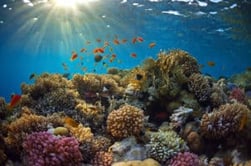Rock Cycle Lesson Plan - A Complete Science Lesson Using the 5E Method of Instruction
By the end of this lesson about the rock cycle, students will be able to classify rocks as either metamorphic, igneous, or sedimentary by identifying and describing the processes of their formation. Each of our lessons is designed using the 5E method of instruction to ensure maximum comprehension by the students. This well-thought out unit does the heavy lifting, giving teachers easy-to-implement, highly engaging lesson plans.
This blog will walk you through each of the steps and activities from the Rock Cycle 5E Lesson Pylan.
ENGAGEMENT
Objective Introduction
At the beginning of the lesson, the class will do a Think-Pair-Share to discuss the objective.
Class Activity
- Ask one student to cut a Snickers bar in half. Then, ask them describe what they see inside the bar.
- Ask another student to take that same bar and smash it. Then, have them describe what they see too.
- Ask another student to take that same bar and place it in a microwave for 30 seconds (You will have to test your microwave to see how long to heat the candy) then describe what they see.
Student Activity
- Have the students work with a partner to brainstorm ideas about the following questions. You may want to give them a very brief intro to each of the three types of rocks.
- What type of rock would the Snickers bar that's been cut in half represent?
- What type of rock would the smashed bar represent?
- What rock would the melted rock represent?
- What are the processes involved in making each rock model?
- Ask for responses from each group.
- Explain to your students that over the next few days, they'll be learning about the processes involved in the formation of igneous, sedimentary, and metamorphic rocks.
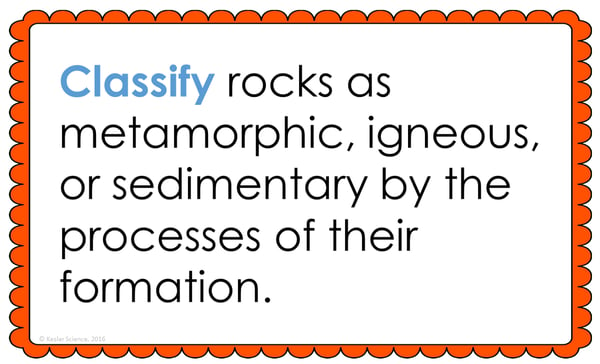
Afterwards, the teacher will help to clear any misconceptions their students might have about the rock cycle. A common but major misconception, for example, is that students may think all rocks are the same and that they cannot be differentiated by sight alone.
Estimated Class Time for the Engagement: 20-30 minutes
EXPLORATION
This student-centered station lab is set up so students can begin to explore the rock cycle. With nine stations in total, you can introduce the it to your middle school students in a variety of ways! Four of these stations are considered input stations where students will learn new information about the different types of rocks, and four of the stations are output stations where students will be demonstrating their mastery of the lesson's material. A bonus station offers challenges for your early finishers and independent learners. You can read more about how I set up the station labs here.
Watch It!
At this station, students will be watching a short video explaining the rock cycle. Students will then answer questions related to the video and record their answers on their lab station sheet. For example: What do the jellybeans represent in the demonstration? List the three main types of rocks and the processes of how they are each created. Explain why the rock cycle doesn’t have to go in order.
Read It!
This station will provide students with a one-page reading about the rock cycle. Students will read about the three different types of rocks and how each are formed. There are four follow-up questions that the students will answer to demonstrate their comprehension of the reading material.
Explore It!
Students will be working in pairs to better understand the rock cycle. Students will be using samples of rocks in containers to determine physical properties they see about each of the samples. Students will record their observations on their lab sheet.
Research It!
The research station will allow students to read information about the types of rocks. Students will then go on a virtual rock collection expedition that tells the student the name of that rock and how that rock was formed. Students will be instructed to complete a few tasks and record answers on their lab sheets.
Organize It!
The Organize It station allows your students to organize rock types with their characteristics and properties. Once students have completed their organization, the teacher will come and check their understanding.
Illustrate It!
Your visual students will love this station. Students will analyze a diagram and have to complete the diagram by labeling the processes involved.
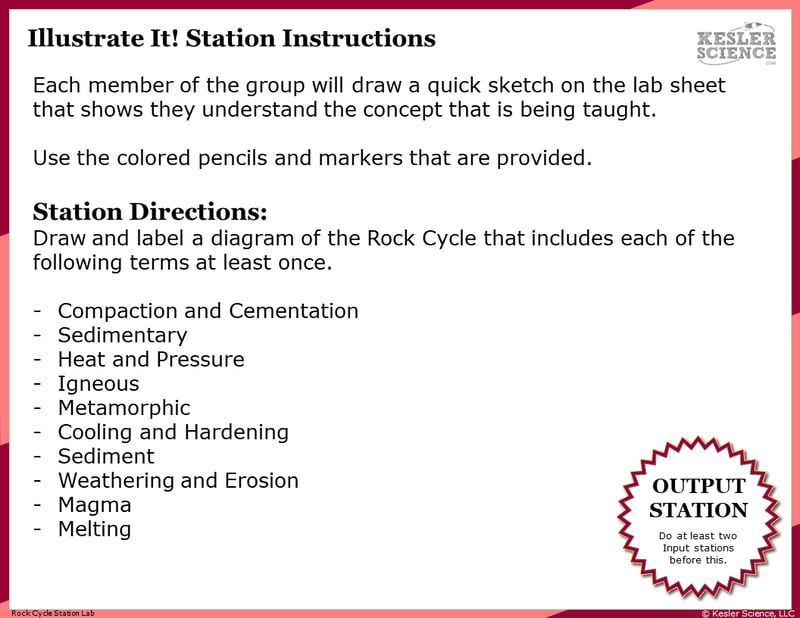
Write It!
Students who can answer open-ended questions about the lab truly understand the concepts that are being taught. At this station, the students will be answering three task cards: Describe the process of how an igneous rock is created. Describe the process of how a sedimentary rock is created. Describe the process of how a metamorphic rock is created.
Assess It!
The Assess It station is where students will go to prove mastery over the concepts they learned in the lab. The questions are setup in a standardized format with multiple choice answers. Some questions include: What type of rock is formed when hot lava is cooled and hardened? Which process is happening at position B on the diagram? What process is happening at position D on the diagram? What process is happening at position A on the diagram?
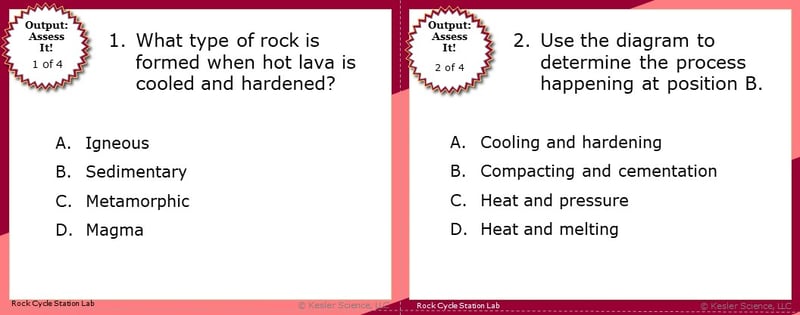
Challenge It! - Bonus Station
Early finishers and advanced students will love the extension activities in this station. Four activity choices offer them ways to expand their learning through mini-games and mini-projects.
Estimated Class Time for the Exploration: One or two 45-minute class periods
EXPLANATION
The explanation activities will become much more engaging for your class once they’ve completed the exploration station lab. During the explanation piece of the lesson, the teacher will be clearing up any misconceptions their students may have about the rock cycle with a variety of materials. These materials include on-level and modified versions of the interactive presentation (may be used individually or projected), anchor charts, and paper or digital interactive notebook activities. If you have students that need modified notes, the 5E lessons come equipped to help give every student access to the lesson.
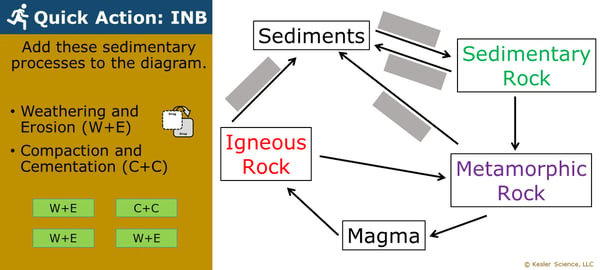
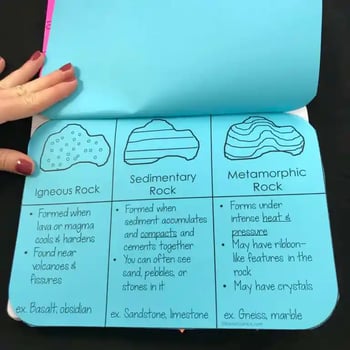
Interactive notebook samples: Above-left is a digital INB activity slide; above-right is an example of the paper INB activities.
The students will also be interacting with their journals using INB templates for rock cycle. Each INB activity is designed to help students compartmentalize information for a greater understanding of the concept. The rock cycle INB templates allow students to focus their notes on understanding the how each of the three main types of rocks are formed.
Estimated Class Time for the Exploration: Two or three 45-minute class periods
ELABORATION
The elaboration section of the 5E method of instruction gives students choices that allow them to prove they’ve mastered the concepts behind the lesson. When students are given a choice, they’re much more enthusiastic and invested in the project than they are when their teachers choose their projects for them. There are a total of nine choices to demonstrate understanding of the rock cycle. A separate set of choices that offer more teacher support are also available for students that need them. Rubrics guide students to doing their best work and assist in grading.

Estimated Class Time for the Elaboration: Two or three 45-minute class periods (can also be used as an at-home project)
EVALUATION
The final piece of the 5E model is to evaluate your students' comprehension. Included in every 5E lesson is a homework assignment, assessment and modified assessment. Research has shown that homework needs to be meaningful and applicable to real-world activities in order to be effective. When possible, I like to give open-ended assessments to truly gauge the student’s comprehension.
Estimated Class Time for the Elaboration: One 45-minute class period
DOWNLOAD THE FULL LESSON NOW
Download Over $100 in FREE Resources
For Middle School Science
Simply create a login below and gain immediate access to a selection of our Kesler Science product line worth $100 - for FREE. There's a full version of every product type! You'll also join tens of thousands of middle school science teachers who receive timely tips and strategies straight to their inbox.




